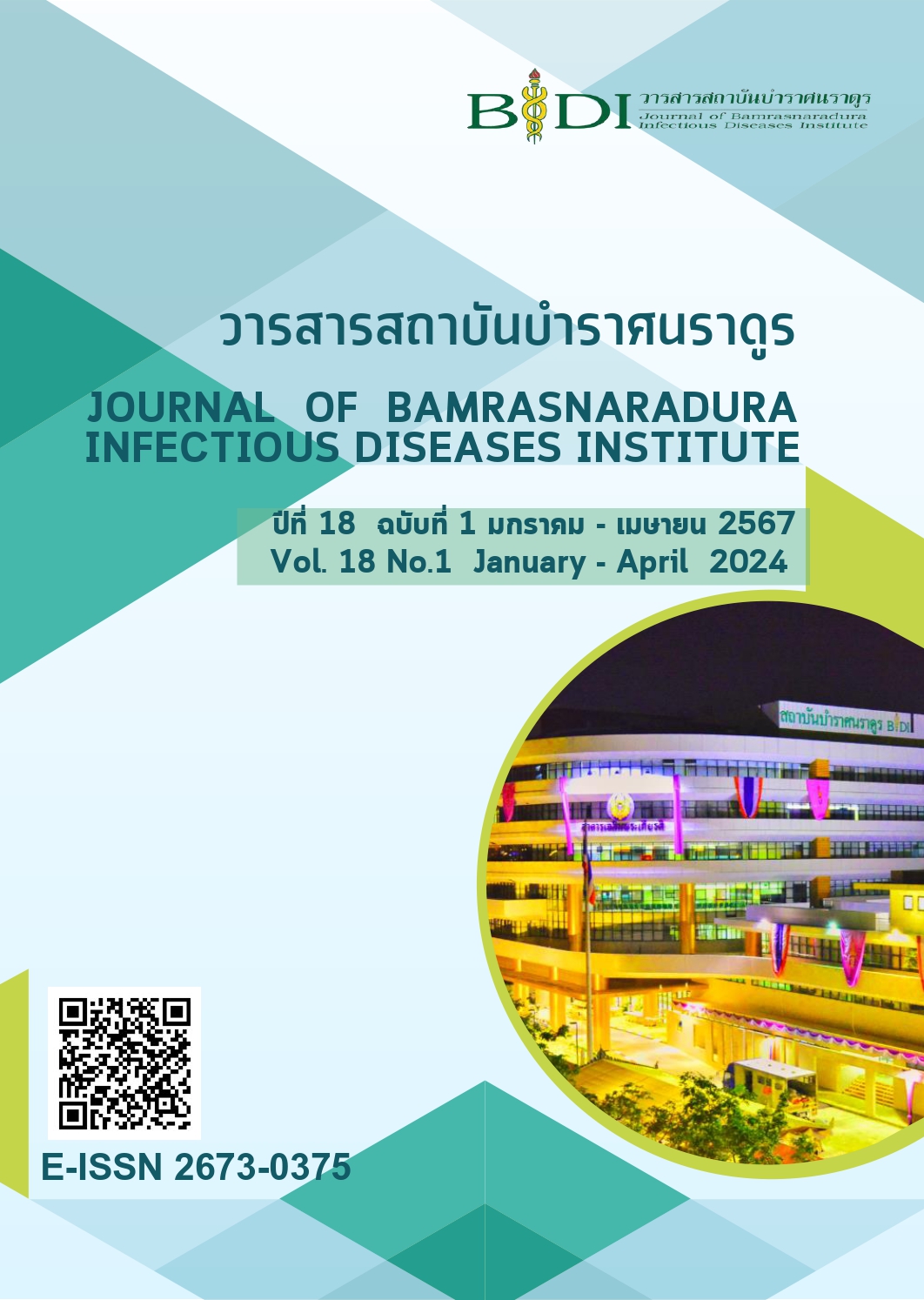ปัจจัยที่มีความสัมพันธ์กับพฤติกรรมการบริโภคอาหารของบุคลากรที่มีภาวะน้ำหนักเกินของสถาบันบำราศนราดูร จังหวัดนนทบุรี
Main Article Content
บทคัดย่อ
การวิจัยเชิงสำรวจแบบภาคตัดขวางนี้ วัตถุประสงค์เพื่อ 1) ศึกษาปัจจัยส่วนบุคคล 2) ศึกษาความรู้เกี่ยวกับโภชนาการ ระดับความรอบรู้ด้านสุขภาพ และการรับรู้ความสามารถของตนเองต่อพฤติกรรมการบริโภคอาหาร 3) ศึกษาพฤติกรรมการบริโภคอาหาร และ 4) ศึกษาความสัมพันธ์ของปัจจัยส่วนบุคคล ความรู้เกี่ยวกับโภชนาการ ระดับความรอบรู้ด้านสุขภาพ และการรับรู้ความสามารถของตนเองต่อพฤติกรรมการบริโภคอาหารกับพฤติกรรมการบริโภคอาหารของบุคลากรสถาบันบำราศนราดูรที่มีภาวะน้ำหนักเกิน กลุ่มตัวอย่าง คือ บุคลากรที่มีภาวะน้ำหนักเกิน สถาบันบำราศนราดูร จังหวัดนนทบุรี จำนวน 243 คน โดยวิธีสุ่มอย่างง่าย แบบสอบถามผ่านการตรวจสอบคุณภาพ วิเคราะห์ข้อมูลค่าความถี่ ร้อยละ ค่าเฉลี่ย ส่วนเบี่ยงเบนมาตรฐาน การทดสอบไคสแควร์ และฟิชเชอร์ เอกแซค ที่ความเชื่อมั่นในการทดสอบทางสถิติที่ระดับนัยสำคัญเท่ากับ 0.05
ผลการวิจัย พบว่ากลุ่มตัวอย่างส่วนใหญ่เป็นเพศหญิง อายุระหว่าง 40 – 49 ปี มีสถานภาพสมรส จบระดับปริญญาตรี มีรายได้ต่อเดือน 10,001-20,000 บาท มีความรู้เกี่ยวกับโภชนาการระดับสูง (ร้อยละ 60.90) ความรอบรู้ด้านสุขภาพโดยภาพรวมระดับไม่เพียงพอ (ร้อยละ 62.10) ความรอบรู้ด้านสุขภาพขั้นพื้นฐานระดับไม่เพียงพอ (ร้อยละ 89.30) ความรอบรู้ด้านสุขภาพขั้นการมีปฏิสัมพันธ์ระดับก้ำกึ่ง (ร้อยละ 41.20) ความรอบรู้ด้านสุขภาพขั้นวิจารณญาณระดับเพียงพอ (ร้อยละ 40.70) และการรับรู้ความสามารถของตนเองต่อพฤติกรรมการบริโภคอาหารระดับปานกลาง (ร้อยละ 46.50) มีพฤติกรรมการบริโภคอาหารระดับพอใช้ (ร้อยละ 75.30) ปัจจัยส่วนบุคคลด้านรายได้ต่อเดือนมีความสัมพันธ์กับพฤติกรรมการบริโภคอาหาร (p = 0.026) ระดับความรอบรู้ด้านสุขภาพโดยภาพรวมมีความสัมพันธ์กับพฤติกรรมการบริโภคอาหาร (p < 0.001) และระดับการรับรู้ความสามารถของตนเองมีความสัมพันธ์กับพฤติกรรมการบริโภคอาหารอย่างมีนัยสำคัญทางสถิติ (p < 0.001)
Article Details
เอกสารอ้างอิง
Bureau of Nutrition, Department of Health, Ministry of Public Health. Nutrition for health promotion operating manual. Bangkok: National Office of Buddhism Printing House; 2015. (in Thai)
Caprio S, Daniels SR, Drewnowski A, Kaufman FR, Palinkas LA, Rosenbloom AL, Schwimmer JB. Influence of race, ethnicity, and culture on childhood obesity: Implications for prevention and treatment: A consensus statement of Shaping America's Health and the Obesity Society. Diabetes Care 2008; 31(11): 2211-21.
Janssen I, LeBlanc AG. Systematic review of the health benefits of physical activity and fitness in school-aged children and youth. Int J Behav Nutr Phys Act 2010; 7(1): 1-6.
Health Information System Development Office. Thai National Health Examination Survey IV (Child Health) [Internet]. 2019 [cited 2019 December 21]. Available from: http://www.hiso.or.th/hiso5/report/report5.php (in Thai)
Nithitantiwat P, Udomsapaya W. Food consumption behavior among Thai adolescents, impacts, and solutions. JPNC 2017; 28(1): 122-128.
Zecevic CA, Tremblay L, Lovsin T, Michel L. Parental influence on young children's physical activity. Int J Pediatr 2010; 2010: 1-9.
World Health Organization Expert Consultation. Appropriate body-mass index for Asian populations and its implications for policy and intervention strategies. Lancet 2004; 363(9403): 157-63.
Yanti N, Ruangchai K. Factors associated with overweight among undergraduate students in a university in Pathum Thani province. VRURDI 2021; 16(2): 71-86. (in Thai)
National Statistical Office, Ministry of Digital Economy and Society. The 2017 Food Consumption Behavior Survey. Bangkok: Social Statistics Division National Statistical Office; 2018. (in Thai)
Department of Health, Ministry of Public Health. Percentage of adults aged 30 – 44 with normal body mass index: Health Region Level [Internet]. 2020 [cited 2020 December 21]. Available from: https://dashboard.anamai.moph.go.th/dashboard/bmi/index?year =2020. (in Thai)
Occupational, Environmental, and Safety Unit, Division of Nursing, Bamrasnaradura Infectious Diseases Institute. The 2019 Annual Staff Health Report: Bamrasnaradura Infectious Diseases Institute. Nonthaburi: Bamrasnaradura Infectious Diseases Institute; 2019. (in Thai)
Krejcie RV, Morgan DW. Determining sample size for research activities. In: Akakul T, editors. Research methodology in behavioral and social sciences. Ubon Ratchathani: Ubon Ratchathani Rajabhat University; 2000. (in Thai)
Sriprajan S. Health literacy and desirable health behavior of personnel in Health Promotion Center Region 7 Khonkean. JBCN Bangkok 2019; 35(1): 277-289. (in Thai)
Thitprapai P, Pansila W. Effect of self-efficacy program with the 351 technics for losses weight for, overweight and obesity for health staff in Kalasin Hospital, Muang district, Kalasin province. J Med Health Sci 2017; 24(3): 22-32. (in Thai)
Pudcharakuntana P, Khungtumneam K, Durongritichtichai V. The factors asociated to the prevalence of obesity in adults in Bang Sao Thong Municipality, Samuth Prakan province. Journal of The Royal Thai Army Nurses 2015; 16(2): 131-139. (in Thai)
Polsiri A. Knowledge, attitudes and behaviors about food consumption of Ramkhamhaeng University undergraduate students. Ramkhamhaeng Research Journal 2008; 11(1): 49-60. (in Thai)
Sridawruang C, Worawong C, Sriyasak A, Howharn C, Manassatchakun P. Relationships between knowledge, attitude, and behavior toward food consumption and physical exercises among rural overweight middle-aged adults. Regional Health Promotion Center 9 Journal 2020; 14(35): 464-482.
Hongkrajok H, Pathumarak N, Masingboon K. Influences of health literacy, perceived self-efficacy,and patient-health care provider communication on self-care behaviors among patients with primary hypertension. Royal Thai Navy Medical Journal 2016; 43(2): 39-54.


